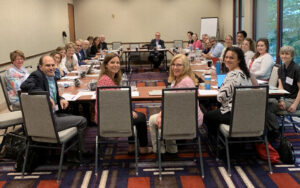• AXYS brought on Robby Miller as an experienced consultant to assist AXYS in creating the ACRC

First meeting of ACRC 2015
• The formation committee, Dr. Tartaglia and Susan Howell of the eXtraordinarY Kids Clinic in Colorado, Jim Moore the AXYS Executive Director and Robby met. The consortium was formed.
• First ACRC meeting held in Denver
• AXYS Clinical Needs and Desires survey, supported by AXYS, Emory University and PCORI began
• AXYS Clinical Needs and Desires survey concluded. Results presented to ACRC by lead investigator Dr. Sharron Close
• Launched with 8 founding clinics: Atlanta, Baltimore, Chicago, Denver, Los Angles, New York, Stanford, Wilmington
• ACRC meets in Denver
• Discussed need for Adult clinics
• Added clinic in Wake-Forest
• ACRC meets in Chicago
• Began Consensus Documents
• Added clinic in Philadelphia
• ACRC meets in Atlanta
• Conducted study to pilot a process to form clinics for adults, funded by the WITH Foundation Grant. Study led by Sharron Close at Emory University and Susan Howell at Colorado Children’s Hospital.

• AXYS awarded grant from the Kosloski Family Foundation to create CME course on Klinefelter Syndrome in Adults
• Added clinics in Boston and Cleveland

Photo of 2019 ACRC meeting
• First virtual ACRC meeting
• Held quarterly ACRC meetings with dedicated discussions on telehealth, Families of Color and Adult clinics
• Added clinic in New York, second clinic in Philadelphia for adults
• Added first international clinics in Vancouver, Canada and Århus, Denmark
• Expanded ACRC to include clinical researchers:
-
- Megan A. Allyse, PhD. Mayo Clinic, United States
- Christine Disteche, PhD, University of Washington, United States
- Claus Gravholt, MD, PhD, Aarhus University Hospital, Århus, Denmark
- Armin Raznahan MD, PhD, National Institutes of Health, United States
- Sophie van Rijn, PhD, Leiden University, The Netherlands
• Published first Consensus Documents
• Added international clinic in London, UK
• Supported by grants from AXYS and The XXYY Project, GALAXY Registry project launched
• The XXYY Project launches ACRC Clinic Visit Stipend
• ACRC Clinic Visit Stipend expanded for all X&Y variations
• Added 2 ACRC Clinics (Sacramento and Chicago) for a total of 18 clinics




